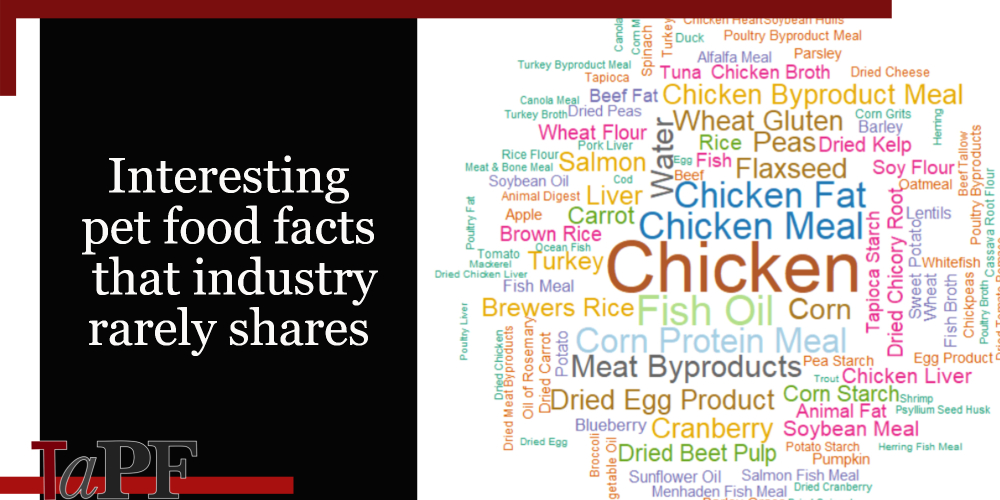A new report published by the research arm of the National Renderers Association (Fats and Proteins Research Foundation) gives pet owners a slight inside look at the pet food industry in the US. The lengthy report is not fully transparent about rendered ingredients in pet food, but it does provide statistics that pet owners typically never learn.
Quoting the report: “In the U.S., there are 518 FDA-registered pet food manufacturing facilities that vary in size and production. …on average, a pet food manufacturing plant buys 18,277 tons of ingredients worth $25.1 million from farmers and farm-product processors.”
“441 cities that have at least one of the 518 U.S. pet food manufacturing facilities, based on data from the Food and Drug Administration (FDA). …there are pet food manufacturing facilities in 43 of 50 states.”

One of the statistics discussed in the report was retail sales of pet food in the US; the report compared sales dollars and sales volume (pounds/tons of pet food sold) in 2020 to 2025.

If you look at Total Sales Volume – the tons of pet food sold in the US has not changed much within the last five years. BUT…when you look at Total Sales, there has been a 70% increase from 2020 to 2025.
This information could indicate that pet food is significantly more expensive than it was five years ago, but it could also indicate that more pet owners are purchasing pet foods of higher quality (more expensive human grade pet foods versus less expensive feed grade pet foods).
With ingredients used in pet foods, the report provided word-cloud charts that display the most commonly used ingredients in cat foods and dogs foods. The larger the font size of the ingredient, the more common use of the ingredient.


And the report discussed how pet food ingredients are commonly “upcycled” – defined as “ingredients that are coproducts from other industries.”

Not provided in the report was information regarding the percentage of upcycled ingredients that are illegal – sourced from diseased animals or animals that have died other than by slaughter (allowed by FDA to be used in pet food with no disclosure to the consumer). Based on the tons of condemned animals annually (provided by USDA), we estimate that at least half of the upcycled ingredients are waste, illegal to be processed into pet foods.
To read the full report from the National Renderers Association – Click Here.
Susan Thixton
Pet Food Safety Advocate
Author Buyer Beware, Co-Author Dinner PAWsible
TruthaboutPetFood.com
Association for Truth in Pet Food

Become a member of our pet food consumer Association. Association for Truth in Pet Food is a a stakeholder organization representing the voice of pet food consumers at AAFCO and with FDA. Your membership helps representatives attend meetings and voice consumer concerns with regulatory authorities. Click Here to learn more.
What’s in Your Pet’s Food?
Is your dog or cat eating risk ingredients? Chinese imports? Petsumer Report tells the ‘rest of the story’ on over 5,000 cat foods, dog foods, and pet treats. 30 Day Satisfaction Guarantee. Click Here to preview Petsumer Report. www.PetsumerReport.com
Find Healthy Pet Foods in Your Area Click Here

The 2025 List
Susan’s List of trusted pet foods. Click Here to learn more.

The 2024/25 Treat List
Susan’s List of trusted pet treat manufacturers. Click Here to learn more.



























T Allen
April 11, 2025 at 3:14 pm
People think that more expensive foods are “better”. More than likely not true. Glad to see cat owners are figuring it out! Cuts to USDA/FDA are going to hurt pets and their owners. Thanks for reporting on this!
Carla
April 12, 2025 at 3:54 am
I find it really hard to believe that flaxseed is a more common ingredient than corn and soya in dog food. Possibly they were using the incorrect term. At least in South Africa, “maize meal” is the term used and not “corn”. I wonder if the graph would have looked different if different terms were used.